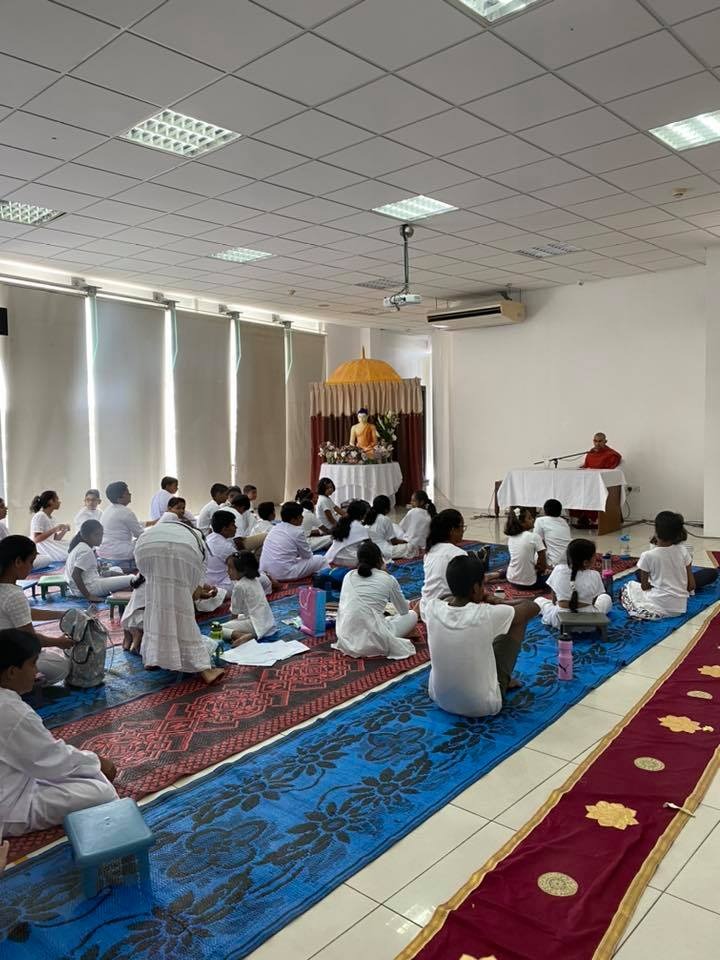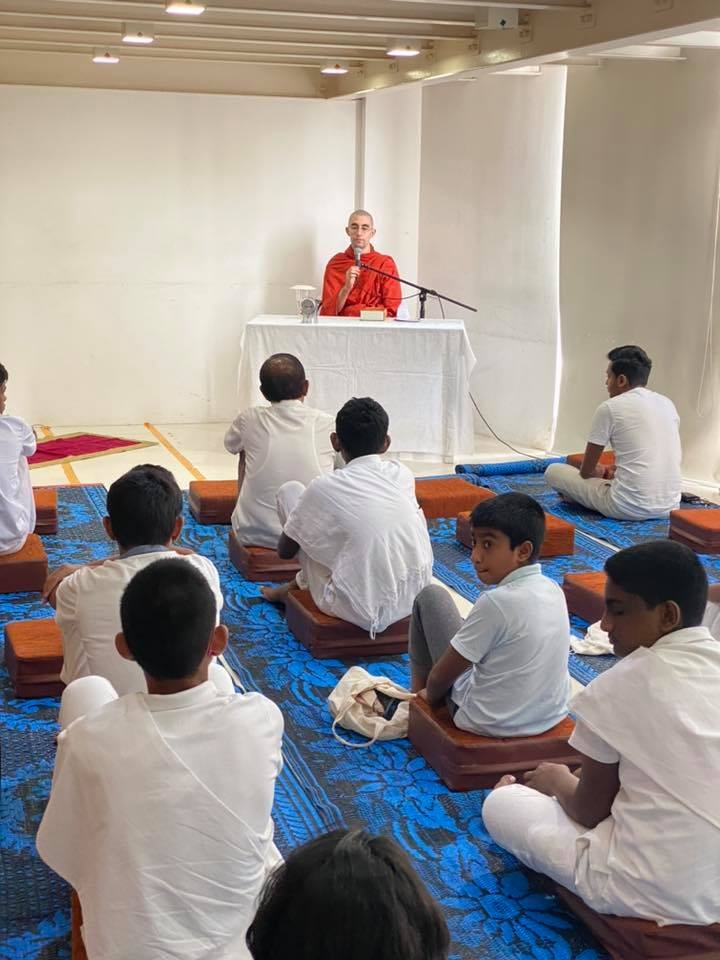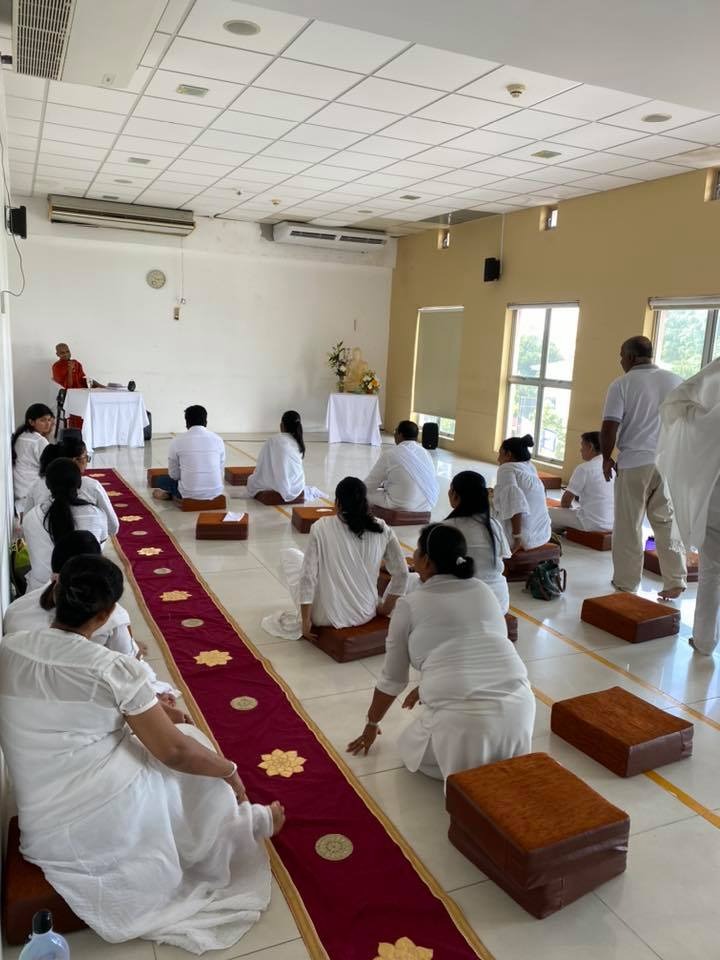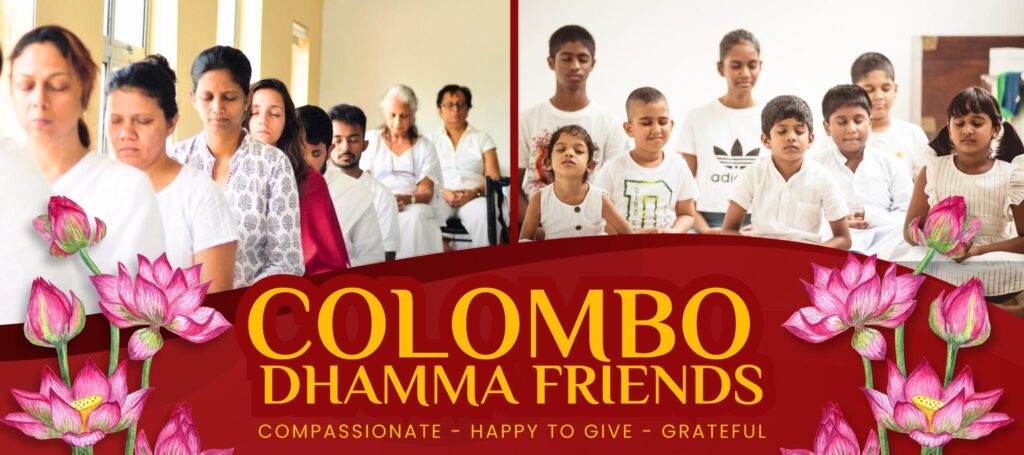
NEXT POYA PROGRAM
VESAK FULL MOON POYA DAY
12TH MAY
Days
Hours
Minutes
Seconds
📋 REGISTRATION
Please confirm your participation by filling out this form
🔊 To Receive Updates
Only People who registered using the above form will be added to our WhatsApp Group via Requests:
If you have any questions, kindly send a WhatsApp message to above numbers:
📋 Poya Days and Significance

This is a key religious and historic date in the calendar for Sri Lankans as it marks Gautama Buddha’s first visit to Sri Lanka on the ninth month after attaining Enlightenment.
The Buddha first visited Mahiyanganaya in the Uva Province of Sri Lanka about 2,500 years ago. According to the ancient texts of Sri Lanka, the Mahavansa and Dipavansa, the Buddha visited to bring an end to fighting between the two main tribes on the island.
During his visit, the Buddha delivered sermons to the tribes. After listening to the sermons, the tribes gave up fighting with each other and started to respect each other with dignity.
Impressed by the sermons, the local God Sumana Saman invited the Buddha to leave his sacred footprint on the peak of the Samanala Mountain. Duruthu poya marks the beginning of the three-month pilgrimage season to Samanala Mountain in order to worship the footprint of the Buddha.
The impression of the footprint is sacred to other religions. In the Hindu tradition, it thought to be the footprint of Shiva and some Christians think it is the footprint of Adam, which is why the mountain is also called Adam’s Peak.

This full moon has special significance for Buddhists in Sri Lanka as it marks two important events. The first commemorates the appointment of Sariputta (Sariyuth) and Moggallana (Mugalan) as the first two chief disciples (Aggasavakes) of Gautama Buddha. Navam Poya also commemorates the first-ever Buddhist Council, held three months after the death of the Buddha. It was here where the Vinaya (the code of fundamental ethics for Buddhist monks) was proclaimed based on the teachings that the Buddha had passed onto his disciples.
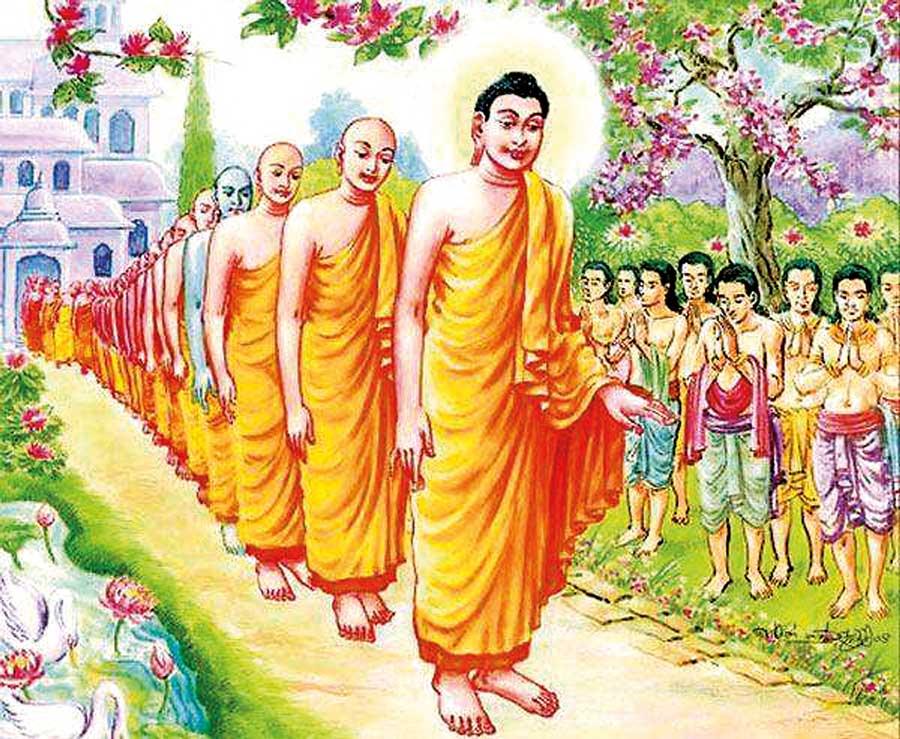
Medin poya is the day when Buddha visited his father King Suddodhana for the first time as the “Samma Sambuddha” (Fully Enlightened One). Medin Poya falls in March.
It was in the seventh year after the enlightenment of Sakyamuni Siddhartha Gautama Buddha that He, together with 20,000 bhikkus set out from Rajagahanuwara to Kapilawasthupura, His birthplace in response to an invitation sent by His father, King Suddodhana. He was visiting his father’s kingdom for the first time as the “Samma Sambuddha” (Fully Enlightened One) and was conducted to the palace by Minister Kaludai whom the King had dispatched to the Veluwana Monastery in Rajagahanuwara where Lord Buddha resided, with instructions to bring back his beloved son. Minister Kaludai was the only successful messenger who was able to accomplish this mission assigned by the King. Previously, nine courtiers, each accompanied by a thousand men had set out on the same mission, but had attained Arahantship and joined the Bhikku order on hearing the Buddha’s preaching. Minister Kaludai was able to convince the Blessed One to return home to visit his dying father, Princess Yasodhara, son Rahula and the many relatives and friends who resided in Kapilawasthupura.

Buddha, in the fifth year of his Supreme Enlightenment, returned to Sri Lanka on a Bak Pura Pasaloswaka Poya Day.
According to the Mahavamsa, an epic poem that relates the history of Sri Lanka, the Buddha visited Nagadipa as he wanted to put an end to the feud between two groups belonging to the Naga community and bring peace to the land.
King Mahodara and his nephew, Chulodara, both from the Naga tribe were quarrelling over a gem-studded throne, Manipalaga, which had been given to Chulodara’s mother by her father.
The Buddha intervened as the rivals were about to meet in battle. He managed to settle the dispute and created unity through preaching the Dhamma sermons.
Having brought peace to the island, the warring kings had offered the precious throne to the Buddha. He courteously declined the gift. The throne was returned to the Naga Kings and was later enshrined in the Rajayathana stupa at Nagadeepa Rajamaha Viharaya, an ancient Buddhist temple built on the site where the events took place.

Vesak Day is one of the biggest days of the year and is celebrated by Buddhists all over the world. Buddhists commemorate the important events that took place in the life of Lord Buddha on this day. First comes the birth of Siddhartha Gautama in Lumbini in Nepal which took place under the arbor of Sat trees where queen Mahamaya gave birth to him. The second event was Siddharta Gautam’s supreme attainment as the Buddha, the Enlightened One. The third event was Lord Buddha’s Parinibbana over 2500 years ago at Kusinagar.
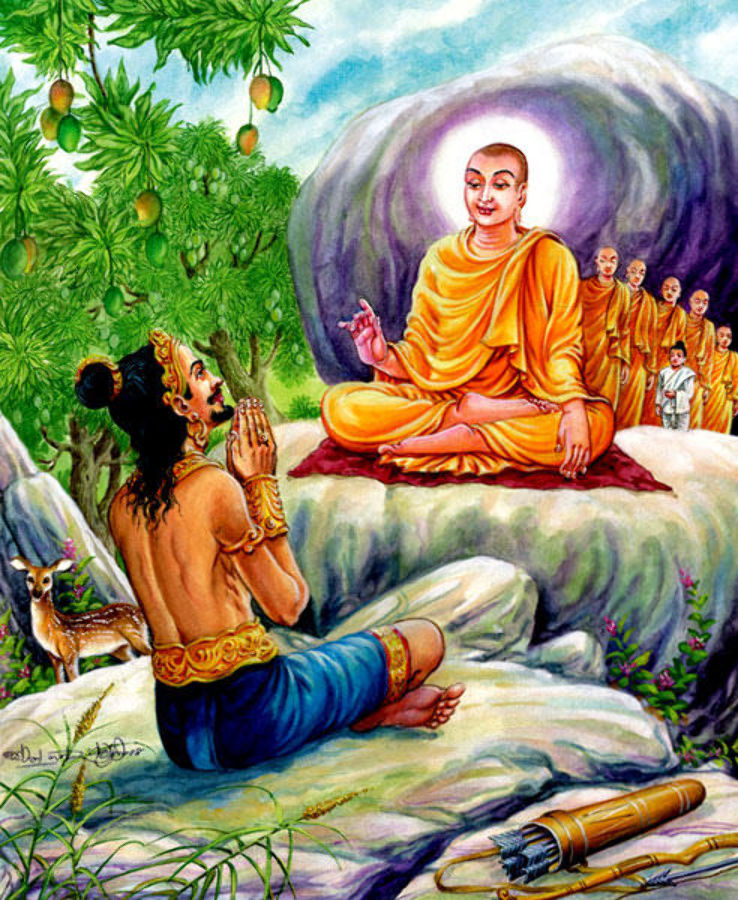
Poson full-moon poya day (Poson Poya Day, Poson Festival) is celebrated the arrival of Buddhism in Sri Lanka in the 3rd century BC, a festival of great historical and religious significance celebrated island-wide by Buddhists. Poson, held on the full moon day of June, commemorates the occasion over 2,000 years ago when Arahat Mahinda, son of Emperor Asoka of India, converted King Devanampiyatissa to Buddhism. The main center of celebration is Mihintale, the ancient monastic complex where the royal missionary monk Mahinda perched the first sermon to the ruling king and at Anuradhapura the ancient capital, to which large crowd of pilgrims converge. Mass religious observances, illuminations pageants are part of the celebrations.

Esala Full Moon Poya is very important in the Buddhist calendar. It was on the Esala Full Moon Poya Day the Buddha arrived at the deer park of Isipathana to preach Dhamma to Ven. Kondangna, Vappa, Bhaddiya, Mahanama and Assaji, the five ascetics. The Buddha delivered His first discourse Dhammacakkappavattana Sutta to them. At the end, the eldest Kondangna Thera attained the first stage of sainthood. According to Buddhist history, many significant events had taken place on the Esala Full Moon Poya Day. Among them, the conception of Prince Siddartha in Queen Mahamaya’s womb occurred on the Esala Full Moon Poya Day. Buddhist literature reveals that a thousand years ago Queen Mahamaya, in one of her previous lives had the same unusual dream on an Esala Full Moon Poya Day.
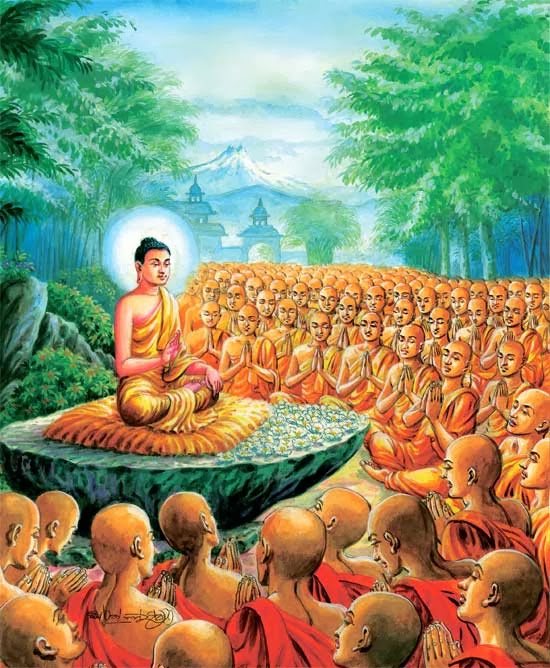
Nikini Poya is the second Poya in the Vas season and falls during August. Nikini Poya marks the first Dhamma Sangayana (convocation) of Buddhist monks. The ‘Vas’ retreat which begins with Esala Poya continues through Nikini Poya as well. ‘Vas’ is a period of approximately four months where all Buddhist monks avoid outdoor activities, spending their days in intense spiritual pursuit.
Their relationship with the lay devotees too takes on more meaning, as the monks are considered to be more accessible for discussions and obtaining advice than at other times. This in turn has a very positive impact on the attitudes and outlook of the lay devotees, and it is they who pay attention to the welfare of the Buddhist monks and address their requirements at this time of retreat. It was under a directive of the Buddha all those centuries ago that this retreat was initiated, and it is continued even to this day.
First Dharma Sangayana (Sangha Council)
The most significant event pertaining to Nikini Full Moon Poya day was the first Dhamma Sangayana (convocation) which was held in the Sattapanni Cave in Rajagahanuwara many centuries ago. Three months had passed since the Parinirvana (Nirvana after death) of the Buddha, and the senior disciples of the Blessed One felt a need to enforce certain principles and rules with regard to the behavior of the Maha Sangha.
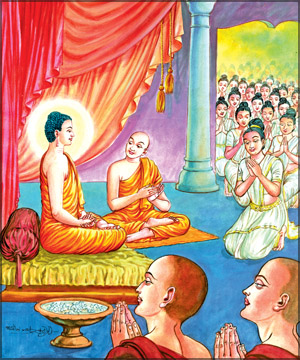
On Binara Poya, Sri Lankan Buddhists commemorate the establishment of the Bhikkhuni Sasanaya (Bhikkhuni Sangha) or Order of the Female Buddhist Monastic. The very first bhikkuni ordained was the stepmother of Buddha, Mahapajapathi Gothami.
Mahapajapathi Gothami was the younger sister of Queen Maha Maya, the mother of Buddha. The Queen died a week after the birth of Buddha and the prince was raised by Mahapajapathi Gothami who subsequently married Buddha’s father King Suddodhana, becoming his stepmother.
The Vas season (Rainy-retreat) continues during the month of Binara, so the bhikkuni remain in their monasteries, engaged in meditation.
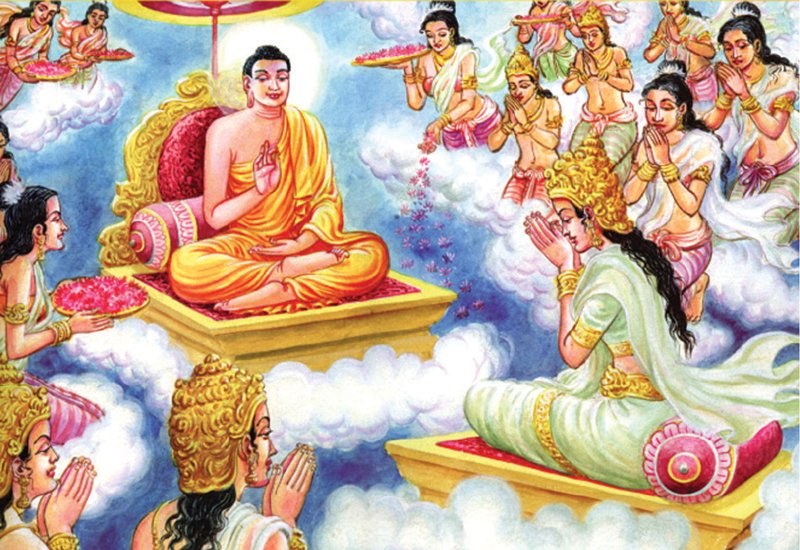
Vap Poya is significant due to the many historical events that took place on this full moon day. Over 2,500 years ago in the northern plains of India, Suddhodana, the Sakya King of Kapilavasthupura, discovered that his young son would grow up to be a great man one day, just as the royal astrologers had predicted at his birth. As the Buddhist scriptures state, the event happened at the royal Vap Magula (Ploughing Festival) where the king was the first to furrow the land and make the soil ready to receive its first batch of paddy seeds. The King had taken his son and heir Prince Siddhartha – the future Gautama Buddha – to witness the ceremony. Whilst the king was engaged in ploughing the land, Prince Siddhartha, who was five-months old, had gone missing. In panic, the king, rose from the field and began to search for the prince. Prince Siddhartha was found in a leafy glade seated cross-legged in a lotus pose, absorbed in deep meditation; with his frame in a state of levitation. Moved by this extraordinary sight, King Suddhodana could not help but pay salutation to his son.

It is the penultimate Poya of the year and marks the end of the rainy season and the conclusion of the three-month retreat (Vassana-Samaya).
This Poya celebrates the obtaining of Vivarana (the assurance of becoming a Buddha) by the Bodhisatta Maitriya and the commissioning of 60 disciples by The Buddha to disperse his teachings.
According to tradition, the foundation stone for the Thuparamaya, Sri Lanka’s first stupa after the introduction of Buddhism was laid on this day many centuries ago.

Celebrates the arrival of the Bo tree sapling in Anuradhapura, brought by Ashoka’s daughter, Sangamitta.
Lord Buddha is said to have attained Enlightenment by meditating under a Bodhi Tree in Bihar, India. In the 3rd century BC, Sangamitta Theri, the daughter of Emperor Ashoka brought a sapling from this Bodhi tree to Sri Lanka, arriving on Unduvap Poya day.
The sapling was planted in 288 BC by King Devanampiya Tissa, in the Mahamevnāwa Park in Anuradhapura, Sri Lanka, where it still grows today. This makes it the oldest living human-planted tree in the world with a known planting date.
Today the tree is one of the most sacred relics for Buddhists in Sri Lanka and respected by Buddhists all over the world. Thousands of devotees come to Anuradhapura on Unduvap Poya day to pay homage to the sacred Bo tree and observe the five precepts in order to lead exemplary lives.
On every full moon poya day, venerable monks from Mahamevnawa Buddhist Monastery will conduct religious programs such as Observance of Sil, Dhamma Talks and Discussions, Meditation and Buddha Vandana
For further information on the Poya Day Sil Programme, please contact Colombo Dhamma Friends of Mahamevnawa. Further details regarding the dress code, schedule, meals, and seating arrangements can be found below.
Our activities are usually made up of a variety of activities. Meditation periods are either guided or silent and last no longer than 30 minutes without a break. There are usually talks on the teachings of the Buddha. We have breaks throughout the events so we can stretch our legs and talk with each other. At some events we do some chanting from a chanting book we provide for everyone to use. You can find more information about these by going to the “Activities” item in the main menu.
Many people like to wear white clothes but this is not compulsory.
You are welcome to sit in any posture you find comfortable. There are lots of chairs. We provide some cushions, but we encourage you to bring your own if you have one. We also encourage you to move to a chair if you become uncomfortable on the floor.
Bring in some flowers from your garden. These are some of the flowers you could bring.
🌼 Nil Katarolu
🌸 Atapethiya
🌼 Araliya (yellow or red)
🌸 Pichcha
🌼 Nil Manel
🌸 Daspethiya
We offer breakfast and lunch to all the participants at our day-long events. The food is mostly non-vegetarian. But we are preparing vegetarian meals also. So don’t worry. If you have any special dietary needs, we ask that you bring food for yourself that doesn’t need to be refrigerated or heated as kitchen space is extremely limited.
Plates and cups are provided, but it’s also fine to bring your own if you feel it would be more convenient. Bring a water bottle with you at all times, especially if you have kids.
We have dedicated parking area for 15-20 vehicles on the premises.
📝 Program Schedule
| 07:00 AM | Observing Eight Precepts Theruwan Vandana, Karaneeya Metta Sutta |
| 07:30 AM | Break – Refreshments |
| 08:00 AM | Dhamma Sermon |
| 09:30 AM | Break |
| 09:40 AM | Meditation |
| 10:10 AM | Dhamma Sermon |
| 10:30 AM | Buddha Puja |
| 11:00 AM | Lunch Dana |
| 12:20 PM | Chanting & sharing merits |
| 01:00 PM | Dhamma Sermon |
| 02:00 PM | Dhamma Discussion |
| 03:00 PM | Meditation |
| 03:30 PM | Clean Asapuwa (Dhamma Hall ,Shrine Hall, Dana Hall, Kitchen, Wash Room) |
| 04:45 PM | Conclusion |
🤝 Contributions for the Poya day program
You can also help the poya program by donating. If you would like to participate in this virtuous deed, please contact us on WhatsApp +94 715962399. Please specify which item you intend to contribute to. Whatsapp the deposit slip, telling us the purpose of the donation. Please use “POYA YOURNAME” for the Beneficiary Remark.
| 🛕 Hall Charges | WhatsApp Us 💬 | Open for Reservation |
| 🎙️ Sound and LED Wall | WhatsApp Us 💬 | Open for Reservation |
| 🍲 Morning dana (Swaminwahanse + Laypeople) | WhatsApp Us 💬 | Open for Reservation |
| 🥘 Lunch dana (Swaminwahanse + Laypeople) | WhatsApp Us 💬 | Open for Reservation |
| 🧃 Gilampasa | WhatsApp Us 💬 | Open for Reservation |
| 🍨 Dessert | WhatsApp Us 💬 | Open for Reservation |
| 🥛 Kiripidu Puja (Morning Vandana) | WhatsApp Us 💬 | Reserved |
| 🌻 Flowers (Morning Vandana) | WhatsApp Us 💬 | Open for Reservation |
| 🚌 Transportation (Monks, Buddha Statue, Dana etc) | WhatsApp Us 💬 | Open for Reservation |
| 👨🏽🏭 Manpower & Other Expenses | WhatsApp Us 💬 | Open for Reservation |
| 💡 Electricity | WhatsApp Us 💬 | Open for Reservation |
| 💧 Water | WhatsApp Us 💬 | Open for Reservation |
💳 Sponsorship Details
| Account Name: | Colombo Dhamma Friends Society Ltd |
| A/C No: | 009160000373 |
| Bank | Sampath Bank |
| Branch: | Pita Kotte |
| Bank Code | 7278 |
| Branch Code | 91 |
| Swift Code: | BSAMLKLX |
| Type of Account: | Current Account |
📷 Gallery

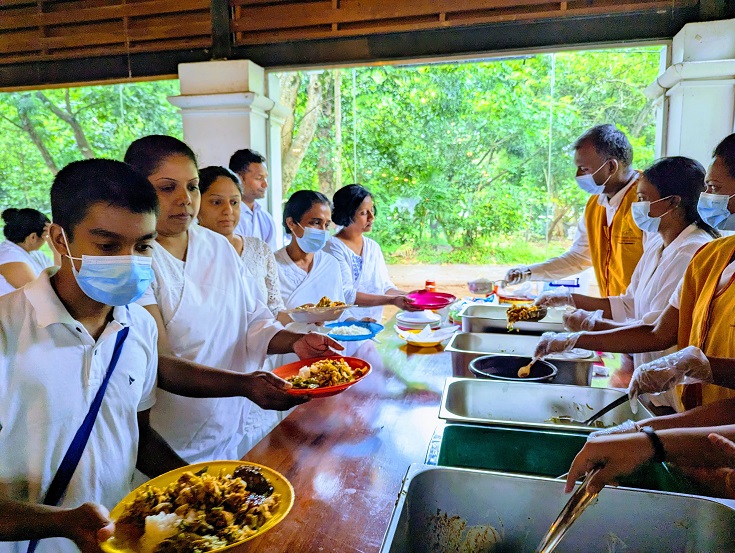
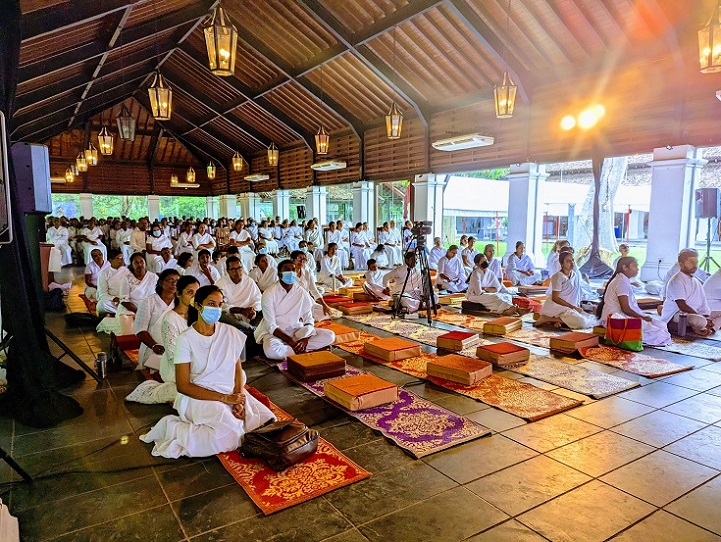



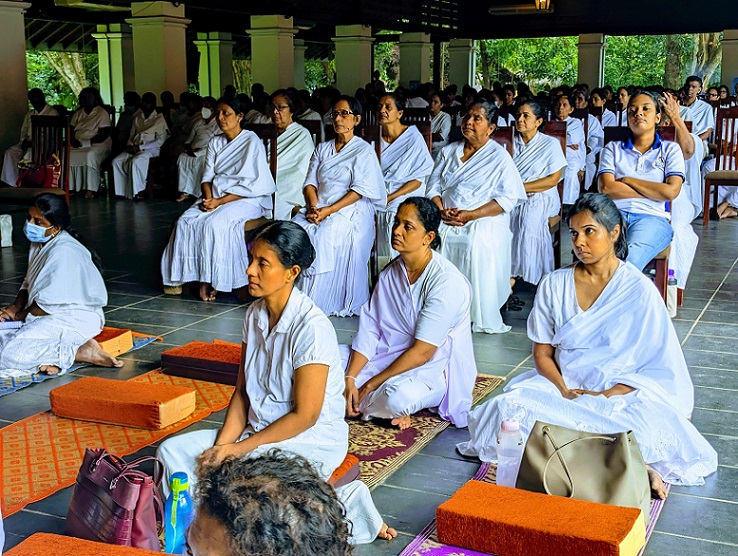





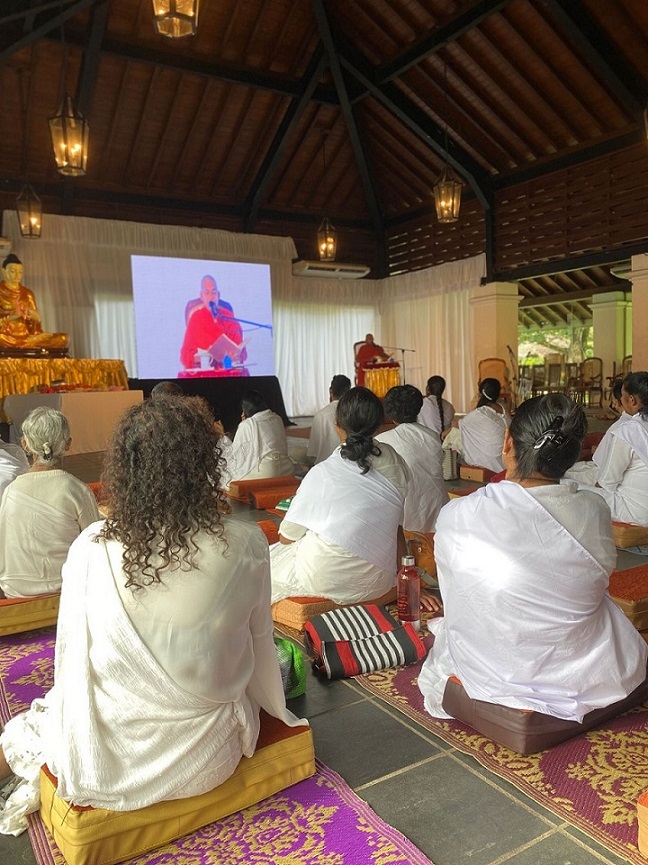

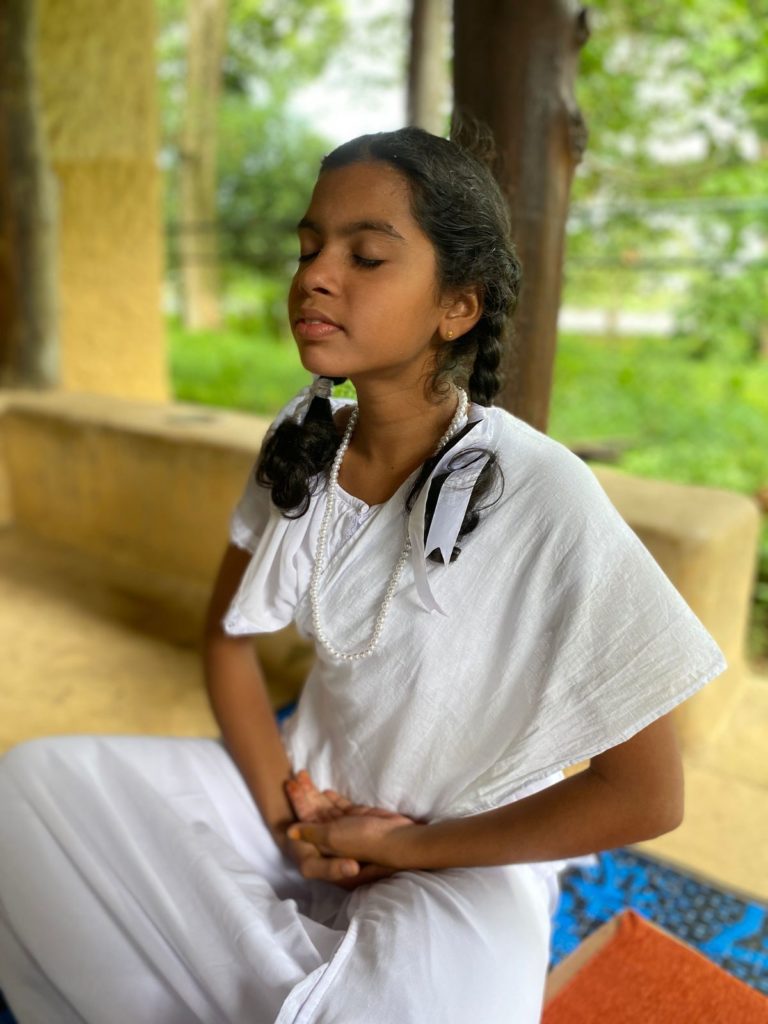

🗒️ Useful Handouts to be ready during the program
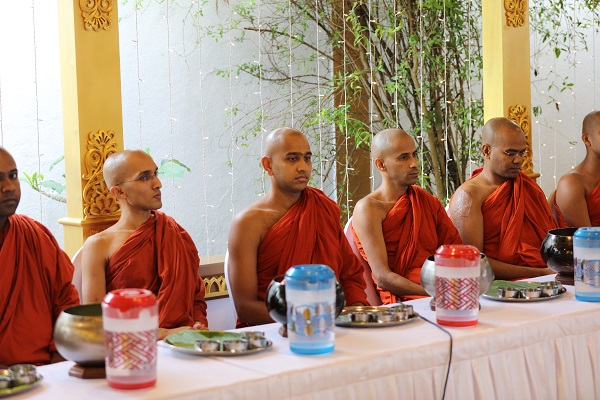
8 Precepts
Read Eight Precepts online
- I observe the precept of abstaining from killing beings.
- I observe the precept of abstaining from stealing.
- I observe the precept of abstaining from incelibacy.
- I observe the precept of abstaining from telling lies.
- I observe the precept of abstaining from taking intoxicating drinks and drugs.
- I observe the precept of abstaining from eating at improper times.
- I observe the precept of abstaining from dancing singing music shows wearing garlands and beautifying with cosmetics.
- I observe the precept of abstaining from using luxurious and comfortable seats and beds.

Buddha Vandana Book
Subtitle for This Block
This is the Vandana book we use that has Sinhala letters, English letters, and English meaning. You can print as a booklet Using Acrobat Reader. (how to)

Qualities of the Supreme Buddha Kavi
Subtitle for This Block

Duk Vindina Jīvitha Gena Kavi
Subtitle for This Block
🙏 Stanza to Worship Monks
Okasa Vandami
This is what we recite to worship monks after a bana or a puja. You can read it online or download the PDF.
Okāsa vandāmi Bhante. Mayākataṁ puññaṁ, sāminā anumodi tabbaṁ.
Translation: Please, Bhante, kindly allow me to share with you the merit I have collected.
(Bhantes: Sādhu, Sādhu, anumodāmi! Good, good, I rejoice!)
Saminā kataṁ puññaṁ, mayhaṁ dātabbaṁ
Translation: Please Bhante, kindly share with me the merit you have collected.
(Bhantes: Sādhu, Sādhu, anumodetha! Good, good, I share!)
Sādhu, Sādhu anumodāmi!
Good, good, I appreciate!
Okāsa! Dvārattena kataṁ sabbaṁ accayaṁ khamatha me Bhante.
Translation: Forgive me, oh Bhante, of any offences I may have committed by body, speech, or mind.
(Bhantes: Kamāmi kamitabbaṁ. I forgive)
Okāsa khamāmi Bhante!
Dutiyam’pi okāsa khamāmi Bhante!
Tatiyam’pi okāsa khamāmi Bhante!
Translation: I ask for forgiveness, oh Bhante!
For a second time, I ask forgiveness, oh Bhante!
For a third time, I ask forgiveness, oh Bhante!
🧎 Meditations

Loving Kindness Meditation
This is the basic loving-kindness meditation that we do at many of the meditation programs here.

Buddhanussati
Download a PDF of the meditation on recollecting the qualities of the Supreme Buddha Kavi Chanting
